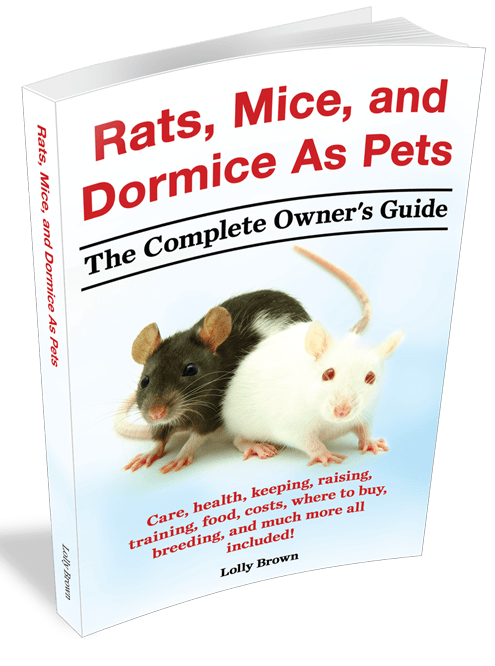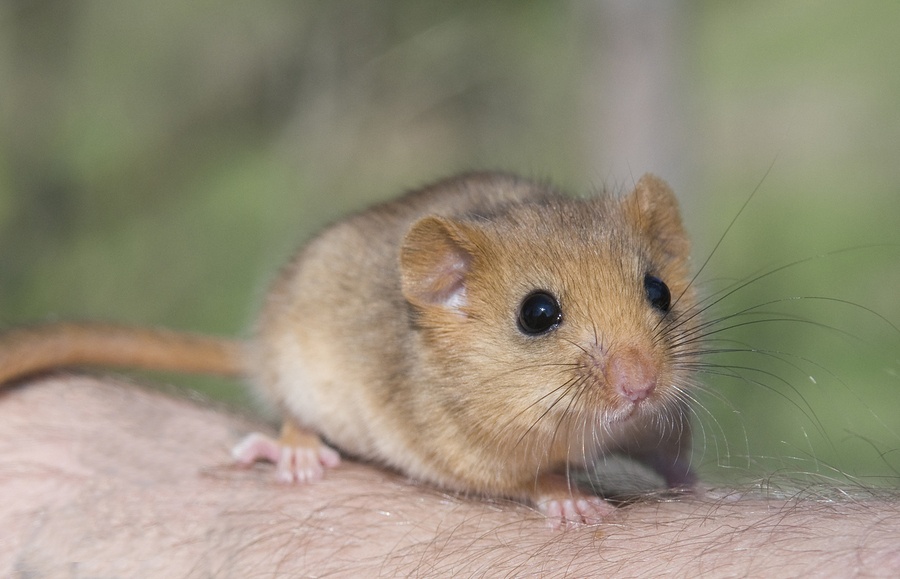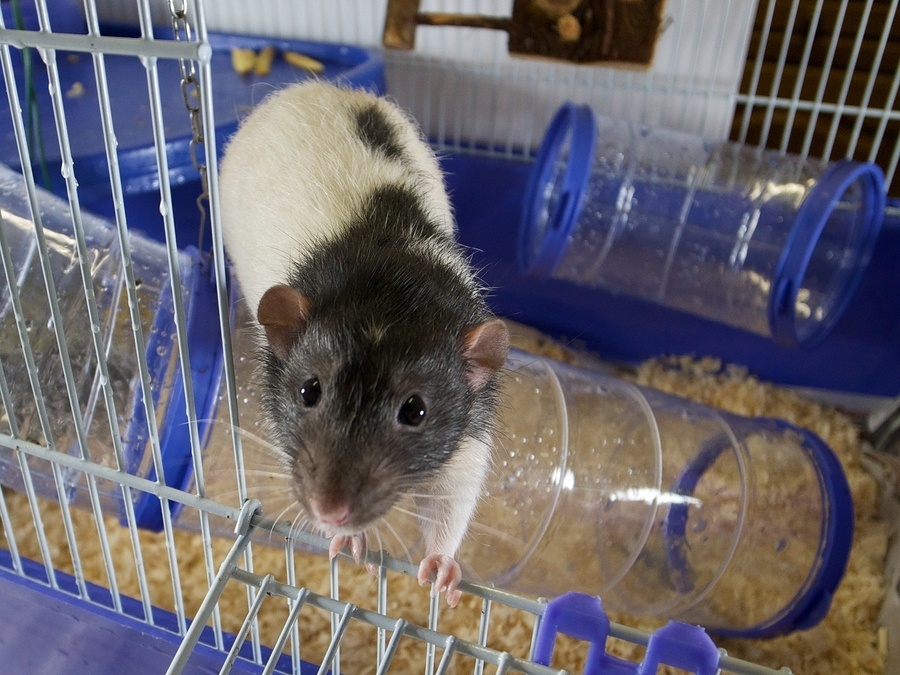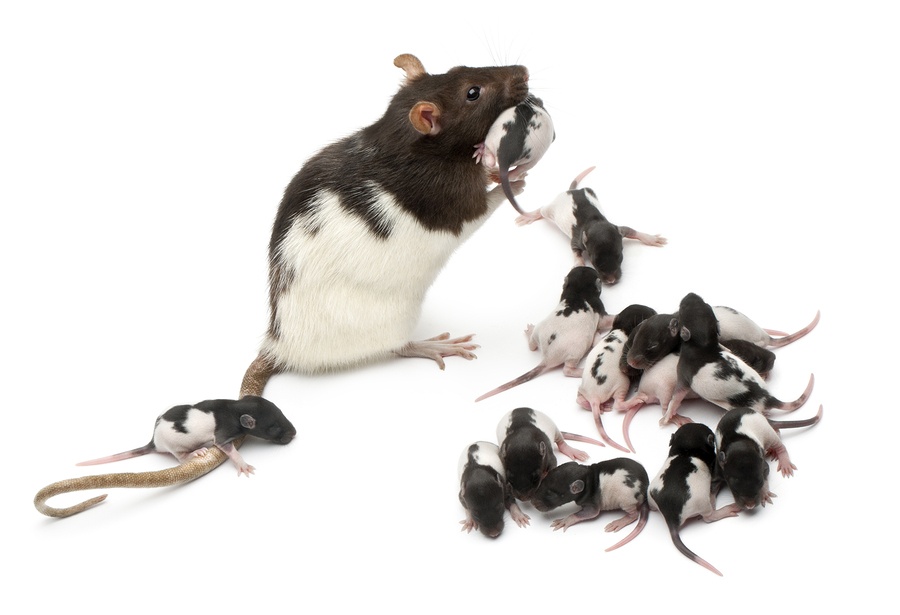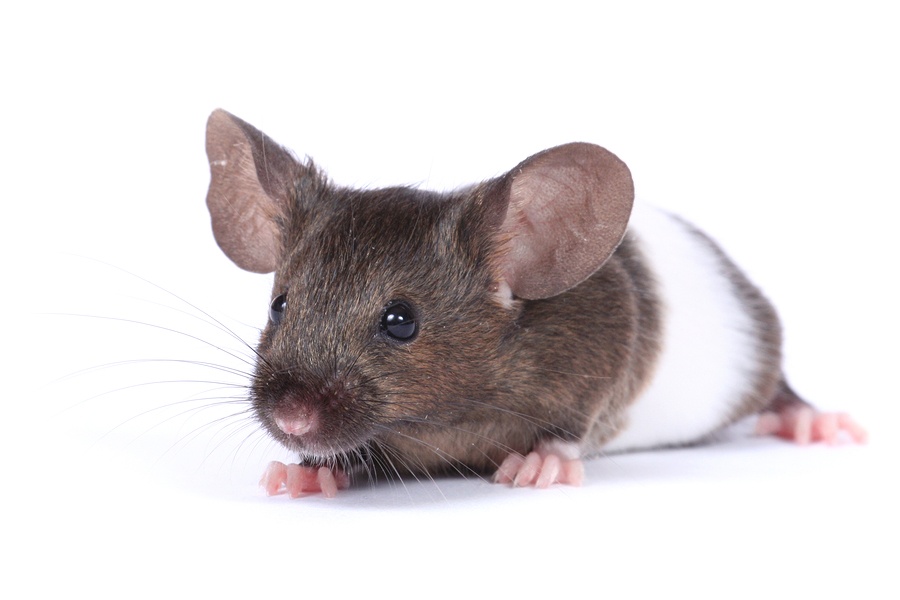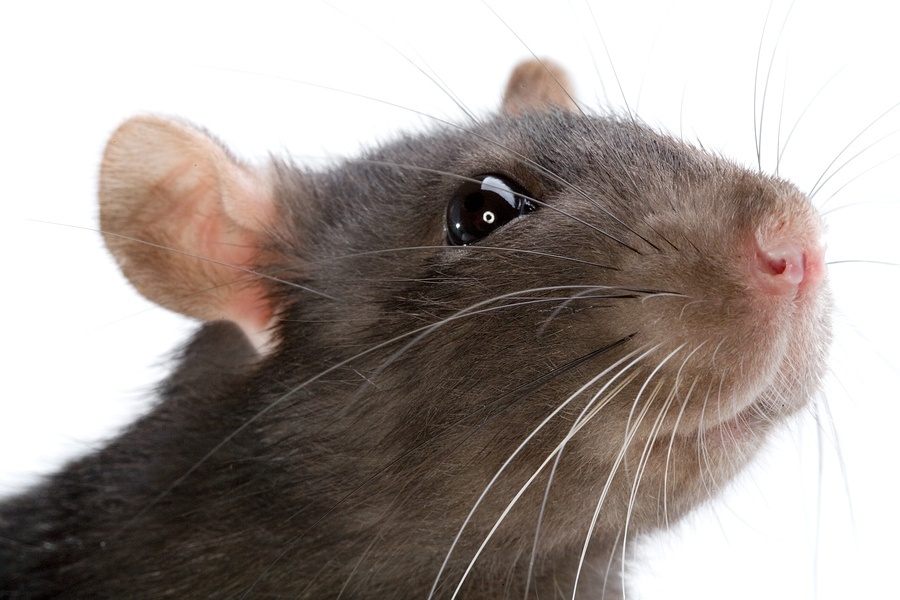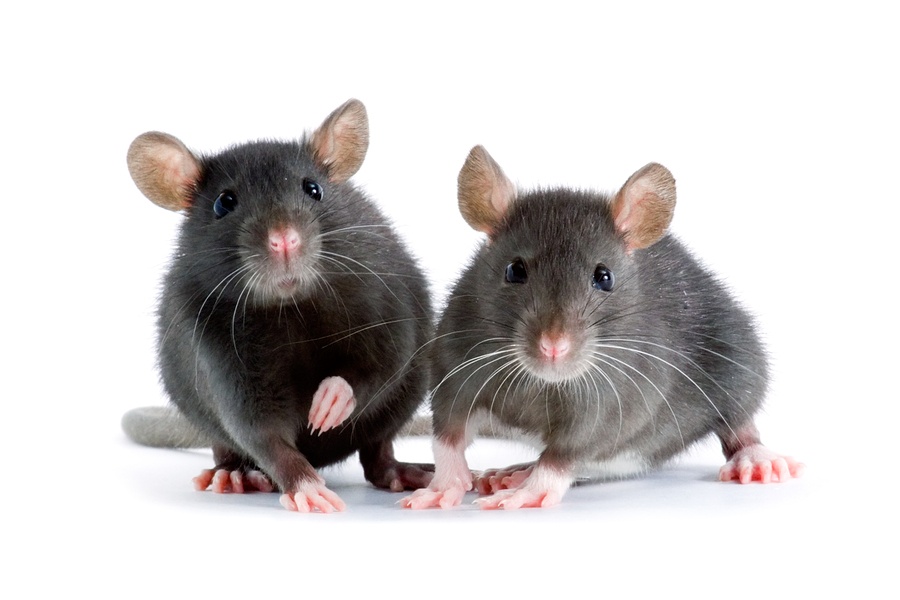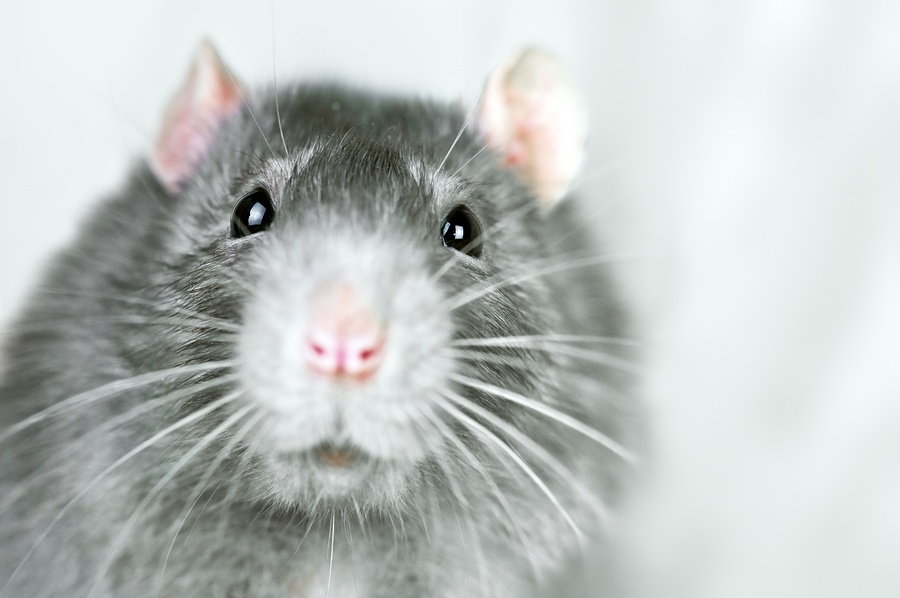Chapters
Navigate to chapter
► Chapter 1: Rats, Mice, and Dormice
► Chapter 2: The World of the Rodent Fancy
► Chapter 3: Buying Rats, Mice, and Dormice
► Chapter 4: Daily Care
► Chapter 5: Health and Breeding
► Chapter 6: An Overview of Rodent Shows
► Chapter 7: Frequently Asked Questions
► Chapter 8: Breeder Directories
Chapter 1: Rats, Mice, and Dormice
Approximately 40% of the earth’s entire mammal population is comprised of rodents. Antarctica is the only continent where rodents don’t live.
It’s common knowledge that rats and mice are rodents, but so are squirrels, beavers, and porcupines.
A rodent’s teeth are specially adapted to chew dense materials. Rodents not only gnaw their food, they also create their homes and make their bedding by gnawing.
For this reason, rodents’ upper and lower incisors grow throughout their lives, and must be kept constantly worn down. When kept as pets, this means a vital part of husbandry is supplying adequate hard toys for gnawing.
What are Rats?
Rats are the most intelligent of all the rodents, although squirrels run them a close second. In the wild, there are two species of rats: Rattus rattus, the roof rat, and Rattus norvegicus, the Norway rat.
The two species cannot interbreed, but are still closely related. Roof rats arrived in America first, although an exact date is not known. Norway rats, however, were reported in the British colonies by 1775.
Today, roof rats are found on both U.S. coastlines and in the American South. The Norway rat is more widely distributed in America, and is also common in Canada and England.
Roof Rats
Roof rats originated in India and are well adapted to tropical climates. They have long tails, large ears, and a somewhat delicate build. You will also see these animals referred to as tree, ship, and black rats.
Norway Rats
The Norway rat is the larger and more common of the two species. It is often called the brown, wharf, sewer, house, or barn rat. It is the direct ancestor of the domesticated rats kept as pets by enthusiasts.
Norway rats originated in an area of Russia located near the Caspian Sea. They are heavier in build and have small ears. By nature this species is better adapted to cooler climates.
Many of the qualities of the Norway rat have been selectively bred into companion domestic rats. They are highly adaptable creatures and opportunistic in their approach to survival.
Their shopping list of abilities include skills at:
- climbing
- digging
- jumping
- swimming
They have been known to chew through both lead and concrete, and can leap as much as four feet / 1.22 meters.
On average, a wild Norway rat weights 10-17 ounces / 284 – 482 grams. The largest ever measured, however, was 23 inches / 58.42 cm long and weighed 2 lbs. 12 oz. / 962 grams.
Domesticated Rats
Domestic rats are very similar in appearance to wild Norway rats. They are, however, extremely docile and receptive to being handled by humans. They are much less aggressive and predatory.
Because domestic rats reach sexual maturity as early as five weeks and produce large litters, they reproduce quickly and easily in the pet trade. They are completely domesticated and would not be able to survive well on their own if turned loose.
Socialization is necessary, however, especially in the critical period of age 2-4 weeks. Rats are highly social with one another and bond with equal strength to their humans, happily grooming, playing, sleeping, and eating with their people.
Because there are so many varieties of domesticated or “fancy” rats, all the various types will be discussed in the next chapter along with fancy mice.
What are Mice?
Mice are physically much smaller than rats. Some people feel this makes them cuter, but that is a matter of personal preference on the part of the owner.
Luxurious whiskers flank a mouse’s pointed snout. When a mouse twitches those whiskers curiously, he makes for a most beguiling sight.
Whiskers or “vibrissae” are also found on the upper lips, and a single whisker is located under each bright, inquisitive eye. Shorter whiskers are located on the chin.
These specialized hairs help mice to sense movements in the air as compensation for their limited visual acuity. They do, however, have a keen sense of smell that further augments their navigational skills.
A mouse uses his front feet in a very hand-like fashion to hold his food and to grasp objects. The front feet have four toes, while the back have five. Mice stand well on their hind feet, and will often assume an upright posture when they find something particularly interesting and worthy of investigation.
Common House Mouse
Mus musculus, the common house mouse is the best-known variety. It has an agouti coat, which, at first glance appears brown. Actually, each individual hair sports ticked bands of color. The muzzle and feet are more lightly shaded, and the tails is long and hairless.
Mice use their tails to help them achieve their trademark acrobatic scampering. As they leap and climb, tackling unsteady surfaces with great ease, their tails function as both a counterweight and a “fifth” stabilizing leg.
Feeder Mice
Feeder mice are the most readily available type in the United States where they are sold as live food for reptiles, a practice that is illegal in the United Kingdom. These mice are raised with no regard to their genetic quality, and are usually poorly fed and housed in deplorable conditions.
Feeder mice are cheap, and can be bought for $.30-$.50 / £0.18-£0.30 each. Typically, however, they can only be purchased in large lots unless a store manager can be cajoled into selling one or two as pets.
It is difficult to obtain a healthy feeder mouse, but with love and attention, they can be turned into good companions. Unfortunately, however, feeder mice have a lifespan of one year or less as compared to 2 – 2.5 years for fancy mice.
Fancy Mice
The world of fancy mice, like that of fancy rats, is extensive and convoluted. The following chapter is dedicated exclusively to these elite animals, who are so pampered, many of them have fine and complicated pedigrees! They
are, indeed, the royalty of the rodent world and are as highly prized by their owners as any other type of show animal.
Laboratory Mice
Both BALB/c or C57BL/6 lab mice make superb pets if you know someone who can acquire the animals for you. The BALB/c is an albino strain of the common house mouse, while the C57BL/6 is extensively used in human disease testing. They are prolific, reproducing easily, and have extremely robust and hardy constitutions.
Wild Mice
Wild mice do not make good pets. They are wary by nature, and don’t usually calm down even when treated with great kindness. Wild mice also carry zoonotic diseases, meaning they can be transferred to humans, a topic that will be covered in detail in the chapter on health.
What Are Dormice?
Dormice are also rodents, and are primarily found in Europe, with some species indigenous to Africa and Asia. They are members of the family Gliridae. Only one species is native to Britain, the hazel dormouse, a whimsical little creature that has found its way into many children’s stories and illustrations.
Dormice range in size from 2.4 to 7.5 inches (6-19 cm) and weigh 0.53 to 6.35 ounces (15-180 grams). Many species live in trees and are nocturnal. Consequently, they are very well adapted to climbing. Although mouse-like in appearance, a dormouse has a furred tail and often over-sized eyes.
Dormice are omnivores, but subsist largely on a diet of fruits and berries, flowers and nuts, and insects. They produce one to two litters per year averaging four offspring following a gestation period of 22-24 days.
Depending on the region in which they live, a dormouse may hibernate for six months or longer. Their lifespan is roughly four years.
These creatures are relatively new in the pet trade, with the most popular species kept as a companion being the African Pygmy Dormouse. Sometimes called “microsquirrels,” the species is small and agile. They are not pets that are good for handling or interactive play, but they are fascinating to watch provided you are a night owl.
In the world of rodents, I would definitely characterize dormice as exotics. They aren’t for everyone, and are likely not a “beginners” rodent. Once a dormouse escapes, it’s extremely difficult to recapture. This is certainly not a pet a child can handle alone. I am including dormice in this book as a class of “advanced” companion rodent.
History of the Rodent Fancy
The history of rodents living with humans is long and convoluted, beginning with an involuntary relationship on the part of mankind. When we ceased to be primarily
hunters and gatherers, shifting to a more agrarian existence, rats and mice happily moved into grain storage bins, helping themselves to our food.
This is, in fact, how cats came to be domesticated as companions to human beings. They earned their keep in the granaries exterminating the rodents, fulfilling their side of the equation in one of the oldest of all adversarial relationships in the animal kingdom.
Not all civilizations, however, viewed rodents as a scourge to be served up to the cats for the taking. In Asia, where mice are believed to have originated, the Chinese kept the tiny animals as pets as early as 1100 BC. The Egyptians accorded supernatural powers to mice, while the Greeks used them in rituals for divination and prophesy.
(Alas, dormice faced a different fate in the same period. The Romans considered them a succulent edible delicacy!)
The first mice and rats to be kept as pets by humans were undoubtedly wild specimens with the typical agouti or brown coloration. Both species, however, quickly adapted to domestication and were easily improved by selective breeding to enhance not only their temperament, but also their size and coat color, quality, and texture.
The mouse fancy can be traced to 18th century Japan with the publication of the booklet, “The Breeding of Curious Varieties of the Mouse.” The hobby was present in England by the late 19th century where the National Mouse Club was founded in 1895 thanks to the work of Walter Maxey, the “father” of the hobby.
In 1901 the National Mouse Club agreed to include rats at the request of Miss Mary Douglas, now considered to be the “mother of the rat fancy.” In 1912, the organization changed its name to the National Mouse and Rat Club. After her death, however, the interest in rats declined, and the club reverted to its original name in 1929.
In roughly this same period, mice and rats were increasingly used in scientific research, most notably the genetic work of Gregor Mendel. This led to the breeding of more unusual specimens, which in turn stimulated greater interest in “fancy” rats and mice as pets.
In January 1976, the National Fancy Rat Society was founded in Great Britain, and exists today in concert with the original National Mouse Club.
The proliferation of the rodent fancy in the United States does not enjoy the same precise documentation. It’s likely that the first companion rodents in the U.S. were either wild mice or laboratory animals. In the 1950s, The American Mouse Club was formed, but was quickly abandoned.
In 1978, the American Fancy Rat and Mouse Association was created, and is still the flagship organization for the hobby in the United States.
Rats, Mice, and Dormice as Pets
Rats make excellent pets. They are very easy to look after, as well as being clean and quiet. The same is true of mice, that are, by nature, gentle, loving, and curious animals.
Although both species are smart, gregarious, and interactive, rats do edge mice out in the intelligence department. Pet rats easily learn their names, pick up extensive vocabularies from their humans, and are receptive to training.
Rats also love to “ride” around on their people, and will quite happily cling to your shoulder as you go about your daily business.
Due to their high level of intelligence, rats do need a lot of time and attention from their humans and will become unhappy and even sick if they don’t get it.
Typically rats do live longer, but on average, both rats and mice survive only 2 to 2.5 years. Mice are the more fragile, weighing just 1-2 ounces (28.3-56.69 grams), but next to the African Pygmy Dormouse, they’re huge.
An African Pygmy Dormouse has an average body length of 3.54 inches / 9 cm (excluding the tail) and weighs 0.63-1.05 ounces (18-30 grams.)
All of these creatures are nocturnal, but rats are generally willing to adjust to your comings and goings. Mice can be especially given to nighttime escapes until they settle down to their life with you. Dormice? Don’t turn your back on those little guys or leave their cage top off for a second!
Never make the mistake of keeping any of your rodent pets in the bedroom with you. Rats are busy by nature, and mice can be absolutely manic — as can dormice. Both of these creatures are either running at top speed, or conked out sound asleep. If your pets are in the room with you and they have a squeaky exercise wheel, sleep for you is not an option.
Rats, mice, and dormice are all fastidious, and there will be no undue odor to the habitat if you do your job and clean up after your pets daily. Both mice and rats will pick one corner of their cage to urinate and defecate, which makes your job of spot cleaning each day much, much easier!
Discussing Life Span
Of the three animals, dormice will live the longest, but I do not recommend them as children’s pets. If, however, you are buying a rat or a mouse for a child, having a discussion about lifespan from the beginning is crucial.
It is rare for a mouse to live more than three years, although it is quite possible with rats. How you care for these animals will clearly enhance their longevity. Not allowing your rats or mice to become obese, for instance, is very important in extending their life.
This alone is an excellent reason for parents to be involved in the care of pet rodents. Rats and mice that get a steady diet of treats will not do well. Regardless, however, children must be prepared for the inevitable with this sort of pet.
In truth, it’s always best to keep multiple mice and rats. This doesn’t negate the impact of the death of an individual pet, but it will ease the period of grief.
Allergies
Neither rats nor mice are hypoallergenic. Rodents can, in fact, cause more allergic reactions in humans than dogs or cats. If your child has known allergies, it’s probably better to go with a pet turtle or lizard (bearing in mind that these animals can also carry salmonella.)
Do understand, however, that allergies are specific to species. Typically the reaction is to the proteins found in the sebaceous and salivary glands. A child with an allergy to cats may not react to a dog or to mouse, for that matter.
If you are concerned, have your child tested for the kind of pet you are considering acquiring. Better to be out the price of the test than to have a heartbroken child when the pet has already moved in and then must be re-homed.
With Children
As with any kind of pet, consider your child’s maturity level and ability to assume responsibilities before getting a rat or a mouse. Both animals are small and can be injured severely if handled incorrectly, or if dropped.
Rats and mice must be fed correctly, and their cages must be kept clean. Rats, in particular, need daily interaction. Dormice, with their diminutive size and high activity profile, should only be considered as pets for older children who are extremely conscientious and reliable.
In general, it’s best not to allow a child under the age of 9 to have sole charge of caring for either rats or mice. Even beyond that age, parents should take at least a supervisory role in the husbandry of the pets.
Children of all ages should be properly educated on being gentle and kind with animals, both physically and verbally. Rats have better vision than mice, but both animals have acute hearing and will be frightened and stressed by sudden loud noises.
With Other Pets
When someone asks me if a pet mouse or rat will get along with the family dog or cat, I am often tempted to ask the person if they understand the concept of “prey.”
No matter how “nice” your cat may be, a rodent looks like lunch in his eyes. The same is typically true for dogs, especially terriers who were, as breeds, developed to be “ratters.”
The only way to keep a successful multi-species household when you mix rodents, dogs, cats — and ferrets, birds, and snakes, for that matter — is a strict policy of segregation. Your rodents will thank you!
Pros and Cons of Rodents as Pets
All of the following points should be considered before you acquire a pet rodent. Only you can decide if these things are pros or cons.
- Rats and mice have relative short lifespans. Dormice live longer, but are not suitable pets for handling.
- Rats, and mice to a lesser degree, are highly trainable. Rats enjoy being held, and some, as you will see, can even be harness trained, but they are still not as interactive as dogs and cats.
- Mice must be kept in a habitat and not allowed to roam free. Some people do allow their rats to have free access in a room or rooms, but those areas must be stringently rat proofed.
- Rats, mice, and dormice are all nocturnal, so you don’t want to keep them in an area where anyone is trying to sleep.
- These are small creatures that can be easily injured if handled incorrectly or dropped.
- All rodentscan trigger severe allergic reactions in people.
There are, however, certainly some clear cut advantages to keeping rodents as pets:
- high intelligence
- low expense
- minimal space
- cheap maintenance including food
- no noise
- clean
- little to no odor
With fancy mice and rats, there is also the possibility of pairing your ownership of a pet with the hobby of showing the animal in competitive exhibitions.
Chapter 2: The World of the Rodent Fancy
Fancy rodents do inhabit a whole “world” of variety, one that can be both confusing and overwhelming. The best way to become conversant with all the wonderful colors, patterns, and combinations is to attend a rat and mouse show.
You will never again think of a mouse as “plain” or a rat as “ordinary” once you’ve seen just how beautiful these domesticated animals really are!
(Since dormice are not shown in competitive exhibitions, they will not be discussed in this chapter.)
Body Types
There are three body types in mice:
- English
- tailless
- gremlin
Rats have three body types:
- standard
- dumbo
- tailless
The term “English” doesn’t really describe a body type, so much as designating a mouse that has English blood. “Tailless” is self-explanatory for both mice and rats. The preference is that there be no tail at all, but if a shortened tail is present, it must be perfectly straight.
Gremlin mice have one normally placed ear, and one on the side of their head. Standard rats have ears that are upright and well-spaced with an oval shape. Dumbo rats have large round ears that form low semi-circles on the side of the head.
Coat Varieties
In fancy mice there are 12 potential coat varieties:
- standard
- satin
- angora
- long hair
- rex
- caracul
- texel
- frizzy
- fuzzy
- hairless
- rhino hairless
- rosette
For rats there are seven coat varieties:
- standard
- rex
- satin
- satinrex
- hairless
- double rex
- dwarf
Coats Common to Rats and Mice
For both rats and mice, the standard coat is dense and thick, with a glossy, lustrous shine. The coats lie flat, but in male rats, slightly longer and coarser guard hairs are permissible. Whiskers should be long and straight.
In rats and mice with satin coats, the hair is thinner, and very fine to the touch but with an exceptionally glossy sheen. In rats, longer guard hairs may be present, but they should not be coarse, and the whiskers are wavy and point in various directions.
For rats and mice with rex coats, the fur lays in waves. In mice, the coat progresses through three stages of development: curly at birth, standing out in all directions, and wavy. In rats, there are obvious guard hairs that can be felt. In both species, the whiskers are curled.
In hairless rats and mice, the animals should be as hairless as possible, with any color and markings allowed. Hairless mice have no whiskers, but if whiskers are present on hairless rats, they must be curled. Rhino hairless mice are identical to hairless, but with deep wrinkling of the skin and oversized ears.
Specific Mice Coats
Some coat types specific to show mice include the angora, which has longer than normal hair with a wool-like consistency and a distinctive “zig zag” pattern. Variations include the Angora Fuzzy and the Angora Rex.
If no zig zag pattern is present, then the mouse is simply said to be a long hair. Again, all combination types are possible, like Long Hair Rex or Long Hair Satin.
Caracul mice have coats with a noticeable wave, but it straightens out more as they age, and so is not as pronounced as that of a rex although it is plush to the touch. The whiskers come in straight, but start to curl after a few days.
Texel mice do have tightly curled fur across the whole body with curly whiskers. The guard hairs are thick, curled, and widely dispersed, remaining in place throughout adulthood.
Frizzy mice are smiler, but the hair is not as curly or crimped in appearance. Overall, however, the texture is coarser and the “frizziness” is quite apparent. Fuzzy mice may have little to no hair, or very thick, curly hair, but their whiskers are curled or crimped.
Finally, rosette mice have whorls of fur placed on each hip in spirals that oppose the standard direction of the main fur.
Specific Rat Coats
Two of the rat specific coats are actually combinations, the Satin Rex and the Double Rex. The Satin Rex fur is densely curled and thick with a coarse, but not harsh texture. The whiskers are short and curl around the muzzle in the direction of the mouth. The satin sheen is pronounced and evident even in the presence of the curling.
The Double Rex coat can vary from the appearance of a partially sheared lamb or even a poodle to a “buzz cut.” There may be small areas of “peach fuzz” on the muzzle, legs, and at the base of the tail. Both the whiskers and the eyelashes should be curled.
Although technically not a coat type, there is another distinct variation, Dwarf rats. They are about one-half to one-third the size of standard rats. Their eyes are big in proportion to the size of their heads, and their ears may also appear overly large. They have busy personalities and are known for exceptionally high levels of energy.
Recognized Mouse Colors
There is an almost dizzying combination of possible colors and patterns in the world of fancy mice. Beginning with the 19 recognized solid or “self” colors. These include:
- black (non-agouti)– Jet black with dark eyes, juveniles display yellow at the base of the tail, ears, genitals, and nipples.
- extreme black– An even deeper black with no yellow evident regardless of age.
- chocolate– Dark, rich brown with brown eyes.
- mock chocolate– A dark, but less intense brown.
- light mock chocolate– A shade lighter than mock chocolate.*
- champagne– Light brown with a pinkish undertone, pink eyes.
- coffee– A softer brown like a cup of coffee with cream, dark eyes.
- beige– A warm shade between tan and off white, dark eyes.
- lilac– An almost blue coat with pink tints suggesting light purple.
- blue– Deep slate blue with purple shading and dark eyes.
- silver– Light chrome-like gray with pink eyes.
- dove– An even mix of blue and chocolate with dark eyes.
- lavender– A mix of silver and champagne with pink eyes.
- recessive yellow– Any shade from red to blonde or dark brown. Reds have pink eyes, blonds and dark browns or sables have dark eyes.
- yellow– Similar to recessive yellow, but with distinct genetic differences and may exhibit white spotting.
- cream– Light, slightly yellow with dark eyes.
- albinoand pink eye white – Appear pure white, but have no pigmentation, pink eyes.
- brown eye white– Pure white, with pigmentation in their coats.
- ruby eye white– Pure white, dark ruby eyes.
* Note that it is often difficult to distinguish one chocolate-toned mouse from the other unless they are compared side by side.
The following shades are also set apart for show purposes:
- agouti– Golden tan with a blue Dark hair on the back, lighter on the sides and belly. Dark eyes.
- cinnamon– Similar to the agouti, but the dark color on the back is more chocolate in tone.
- blueagouti – Each hair is dark blue at the base, progressing through shades of blue toward white at the tip.
- argenté – Yellow top coat with lilac
- silverargenté – Banded hairs progressing from a slate blue undercoat through silver to white at the tip.
- chinchilla– Hairs are blue at the base, gray in the middle, tipped in black. Fox belly and dark eyes.
- silvered – May be completely white with no pigmentation, fully colored, colored with white tips, or banded.
Recognized Mouse Color Patterns
Show mice can also display a broad range of distinct patterns in their coats. The following are accepted for show purposes.
- brindle– Tiger striped from the head to the tail with less distinct stripes on the stomach.
- roan– A mix of white and any other color evenly distributed across the body with more white on the belly.
- merle– A marbled pattern of solid patches on a light base color.
- Himalayan– White with pink eyes and dark points at the feet, ears, nose, and tail.
- color point beige– Cream body similar to the Himalayan, but with darker points at the feet, ears, nose, and tail with dark eyes.
- Siamese– A pointed variation with larger areas of shading at the points and ruby eyes. Very similar to a Siamese cat.
- Reverse Siamese– Any color, but with white points at the feet, ears, nose, and tail. Often the base color is coffee.
- Burmese– Almost any color, but with dark points at the feet, ears, nose, and tail that are the same color as but darker than the body color.
- Sable– Dark on the back fading to a reddish tan hue on the underside and belly.
- Splashed– Mice of any color, but with dark splashes on the body.
- Tanand Fox – A distinctly tan, highly delineated upper color region with a lighter belly.
- Tan– Tan with a dark golden red underside. A definitive line marks the top color from the bottom running down the jaw, along the neck, and sides.
- Fox– Similar coloration to the tan, but with a pure white belly. Seen in all colors and patterns.
Recognized Mouse Markings
After color and patterning, mice are also described by specific markings like “banded” or “belted.” Some markings, however, are not so clearly specific and take a practiced eye to recognize.
- belted– Belted and banded are similar in that both are wide, mid-section markings. Belted mice have white bands that begin on and are at their thickest point on the back. They then come down the side and around the belly, typically narrowing. In especially well-bred specimens, however, the belt is almost perfectly even.
- banded– A solid colored mouse with a white band at the midsection thinner on the belly and broken without connecting at the spine. May be a double band, or so wide half the body is covered.
- piebald– The best way to describe a piebald marking is that the pattern is like that seen on black and white Holstein cattle.
- Dutch– On each side of the face an oval patch begins at the front of the eye and runs back to the ear without touching the whiskers. There may be a white stripe between the facial markings beginning at the nose. Any body color is acceptable, but the spots must be clean cut.
- broken merle– A mouse with a coat combining roan, merle, and white patches of any color.
- broken tan– Mice of any color with tan on the belly and white spotting.
- variegated– White spotted mice, but the edges of the spots are jagged. Not to be confused with splashed, which is a color-on-color pattern.
- rump white and colored rump – White rump with a distinct body color. The line between the two areas should be even and well defined around the body.
- rump black and colored rump – Identical to the rump white, but with a black posterior section.
- tri-color– A mouse with three colors in any mix of splashes, spots, bandings, beltings, variegations, and colors. Most are black, brown, and white.
Recognized Rat Colors
The following are all recognized colors in fancy show rats. Amazingly, the list is even more extensive than that for fancy mice!
- black – Deep lustrous black that runs to the skin.
- beige– Warm, medium tan that is not overly dark.
- American blue– Deep slate blue with a pale undercoat.
- pink-eyed white – White with red eyes.
- black-eyed white – White with black eyes.
- Russian blue– Dark gray with a ticked, heathering
- Russian dove– Dusty, warm gray with darker guard hairs and subtle ticked heathering.
- Russian silver– Pale, icy gray with faintly speckled heathering.
- Russian beige– Pale wheat with blue-gray heathering.
- Mink – Even gray brown with a blue
- silver– Pale, cool blue with frosting of white creating a sparkle.
- champagne– Light, warm sand color.
- pearl – Silver cream. Individual hairs tipped in gray. Belly fur and feet are pale silver
- platinum– Pale blue gray in even tone with matching feet.
- platinumpearl – Even undercoat of blue cream with matching feet. Each hair is tipped in blue gray.
- Havana– A warm, light brown that is the color of milk chocolate.
- black-eyed cream– Creamy white body with no odd colored hairs or patches.
- chocolate– Even, rich brown with no white hairs or patches.
- merle– Base color is mink with distributed pattern of numerous and distinct dark spots.
- silvered – Silvering can be present in any coat or color. The silvered hairs have white tips, which give the coat a shimmering effect.
- agouti – Chestnut brown with gray undercoat and black guard hairs. Belly and feet are silver gray.
- American blueagouti – Overall medium slate with pale gray undercoat and dark blue guard hairs. Silver belly and feet.
- cinnamon– Warm russet brown with even dark ticking the length of the hair. Medium gray undercoat and light gray belly and feet.
- cinnamon pearl– Multiple bands of cream, blue and orange giving a gold appearance with silver guard hairs. Belly is pale silver gray.
- fawn – Bright orange with a pale gray undercolor. Silver guard hairs and silver-creambelly fur.
- Russian blueagouti – Even mixed Russian Blue and agouti with heathering and silver belly fur.
- Platinum agouti– Soft gray ticking over warm cream with an overall blue Undercolor is a lighter blue and the belly and feet are light silver.
- Russian fawn – Golden orange with an even ticking of silverand silver-blue guard hairs. Belly and throat are cream.
- Russian cinnamon– Mixture of cream, light gold, and brown on a silver-blue base with a pale undercoat. Belly and feet are light gray.
Provisional Colors
The following colorations have been accepted for provisional show status.
- Wheaton Point Siamese– A bright cream coat with even but gradual shading at the saddle and hindquarters. The darkest points are at the base of the tail, on the feet, and at the nose and ears. No white should be present.
- Russian Blue SableBurmese – A warm, creamy blue body with darker points and faint light speckling or heathering. There should be no suggestion of black at the points.
- Russian Blue Wheaton SableBurmese – Warm gray body with ticking over a light gray body. A yellow tone to the coat is normal. There should be no suggestion of black at the points.
- American Blue SableBurmese – Medium warm brown body with a suggestion of blue
- Rose Gray – Intermingled brown guard hairs on a pearl white background create an overall light brown appearance. The belly should be white. Head spots and blazes are acceptable within set parameters.
Recognized Rat Markings
Specific markings recognized in the rat fancy include:
- self – All one color with no markings.
- Berkshire – Underside should be full white with symmetrical markings. The feet and as much as half of the tail end should be white. Head spots and blazes, if small, are acceptable.
- English Irish – Between the two front feet and on the chest there should be a white, well defined, equilateral triangle. All four feet and the tip of the tail should also be white.
- American Irish – A body of any standardized color with the lower belly, tail, tip, and feet showing white markings. On the belly, the spots should be round, even, and of moderate size with no extension to the chest or legs.
- Variegated – Any recognized color on the head and shoulders with a blaze or head spot present. The back should have distinct and clear spots and patches, while the underside is a clean white.
- Dalmatian– Numerous spots of a similar size in any recognized color on a white background.
- Hooded– Rats with a white body and a hood in any accepted color that covers the shoulders, chest, head, neck, and throat. There should be no break or white spots in the hood. The color continues from the center of the shoulders down to the base of the tail in an unbroken line or stripe. As much of the tail as possible should also be colored.
- Bareback– Any standardized color on the head, neck, shoulders, and throat with white back, sides, belly, feet, and tail.
- Capped– Any standardized color on the head and ears as well as the underside of the jaw and chin. The shoulders, body, feet, belly, and tail are completely white.
- Masked– A mask over the face in any standardized color should cover both eyes. The chin, throat, muzzle, jowls, ears, body, and tail are completely white.
- Banded – The feet, legs, underside, sides, neck, and jaw line should be white with a wide band of color on the back.
- Blazed– A blaze is a wedge-shaped, symmetrical white marking. It must start midway between the eyes and ears as a fine point and encompass the bridge of the nose, the nose itself, the whisker bed and the mouth to form a thin triangle.
- Roan – White hairs blended with any recognized color to create a faded or salt-and-pepper look.
- Striped– The legs, underside, and sides are white, creating a thick strip across the back. An inverted blaze in the shape of a V should be present, with the jaw line and underside of the head also to be white.
- Head spot– Clear and distinct white markings centrally placed between the eyes and ears on top of the face.
- Downunder Berkshire– Any recognized solid body color on top with a colored stripe down the length of a white belly. The feet and as much as half of the tail are also white.
- Downunder Hooded– Rats with a white body and a hood in any accepted color. The hood should cover the head, neck, throat, chest, and shoulders. A line should continue from the center of the hood at the shoulders down the spine to the base of the tail. A matching belly stripe extends from the colored chest down to and filling the area between the hind legs.
- Downunder Hooded/Spotted – Similar to the Downunder Hooded above, but with as many side spots as possible. The back and belly stripe should match.
- Downunder Spotted – Back and belly stripes in any recognized color, but as broken and spotted as possible. The appearance should be that of spotting all over the back and underside.
- Downunder Variegated – Any recognized color on the head and shoulders with either a head spot or blaze present. The back should have distinct and clear spots and patches in the same color. There should be a symmetrical and clean belly stripe.
Standardized Rat Color Patterns
In addition to these specifications for colors and markings, the following color patterns are also recognized in the rat fancy.
- Siamese– A Siamese rat’s body is ivory or a medium beige with gradual and even shading. The points should be dark and located on the nose, ears, feet, and at the base of the tail.
- Seal Point – Similar to the Siamese above, the points should be much darker, with the body color the darker, warmer beige.
- Russian Blue Point – The ivory color of the body is in contrast to smokey blue-gray points with some light heathering
- American Blue Point – An ivory rat with cool yellow to brown shaded points with a very distinct level of contrast.
- Burmese– The body is a medium sepia tone with darker sepia points at the feet, tail, nose, and ears.
- Sable Burmese – A rich, brown rat with even darker points at the feet, tail, nose, and ears.
- Russian Blue Burmese– A medium gray body with undertones in tan and subtle ticking. The points are deep gray and found at the feet, tail, nose, and ears.
- Russian Blue Wheaton Burmese– A mid-sand body with ticking in blue and some yellow tone to the coat. Light gray base coat with silvery belly and distinctly darker points.
- American Blue Burmese– Warm, light brown body with some suggestion of blue Darker points in the same shade with a white-sliver undercoat in ideal specimens.
- Russian Silver Point Siamese– Ivory rat with pale, icy blue-gray points with a distinct shimmer. Some heathering is normal.
- Black Eyed Siamese– Medium beige body with dark points evenly shaded and black eyes.
- Seal Point – Medium beigebody with dark seal color shading that is rich and distinct.
- Russian Blue Point – Bright ivory body with smokey bluegray points and light heathering. Marked contrast between the points and body color.
- American Blue Point – Ivory body with cool yellowto brown shading at the points. Contrast should be clear and distinct.
- Himalayan– White base with dark points evenly shaded. Red eyes.
- Seal Point – Dark seal to sepia shaded points in distinct contrast against a white body.
- American Blue Point – White body with cool, subdued points in a yellow/ brown shading.
- Black Eyed Himalayan– White base with dark points and black eyes.
New Varieties – January 2014
The following varieties were recognized by the National Fancy Rat Society in January 2014.
- apricot agouti– Pale apricot with evenly ticked guard hairs in silver. The undercolor is ice blue with a pale cream belly color.
- Essex capped – A white rat with a cap of color on the top of the head and extending a short way behind the ears. The nose tip, however, should be white, and there should be a white triangle between the eyes that points to the back.
- bluepoint Himalayan – White with medium smokey blue points.
- cinnamonchinchilla – Light brown top color intermingled with brown guard hairs over a pearl white background. The appearance is sandy and speckled.
- coffee– A rich caramel to be presented in an even color with no patches or white hairs present.
- creamagouti – Mid-cream background with mixed mid-grey ticking fading down the sides to a pale belly. Lighter fur around the eyes and on the whisker bed.
- marten – A dark gray body with some light heathering. Lighter fur on the face and whisker bed, around the eyes, and behind the ears. The belly is a paler shade of gray.
- powder blue– A pale blue with silver base fur and a pale silver belly. The color should be even, with no white patches.
- pink eyed ivory – Pale creamy white with no odd colored hairs. The ears, tail, and eyes should all be pink.
- Russian doveagouti – A warm gray with pink ticking over a light fawn background. Some heathering, light silver belly, and gray feet.
- Russian pearl – Medium silverwith a cream, undercolor. The majority of the hairs should be pearl tipped in gray, and the top coat has a faint metallic sheen. The belly fur is pale and creamy gray.
- satin– A high sheen coat of any recognized color with a metallic gloss.
- silveragouti – Mid-gray ticking on a pale ivory background with no hint of blue or brown. The ticking on the back fades to a belly of pale ivory. The fur on the face around the eyes and whisker bed is paler.
- turpin – A rat with a complex series of markingsincluding a wide band down the back, two colored triangles from the ears to the points of the eyes, and mixed color on the back giving an appearance of sprinkling.
Want to read the entire thing?
